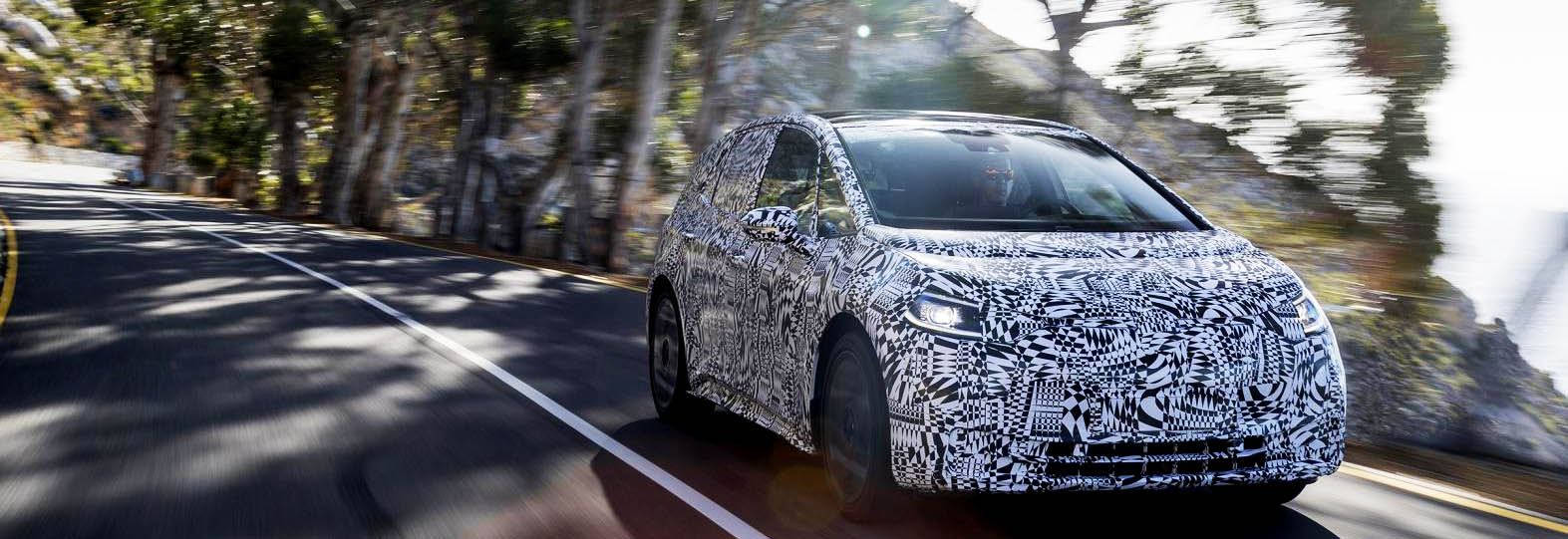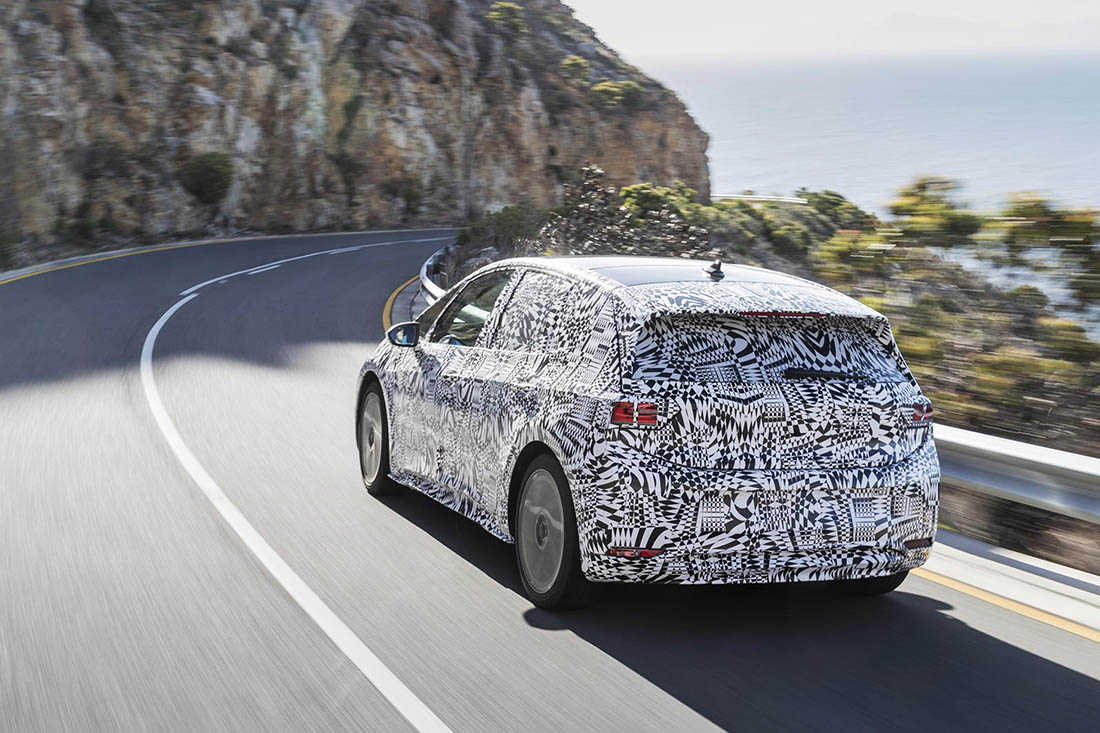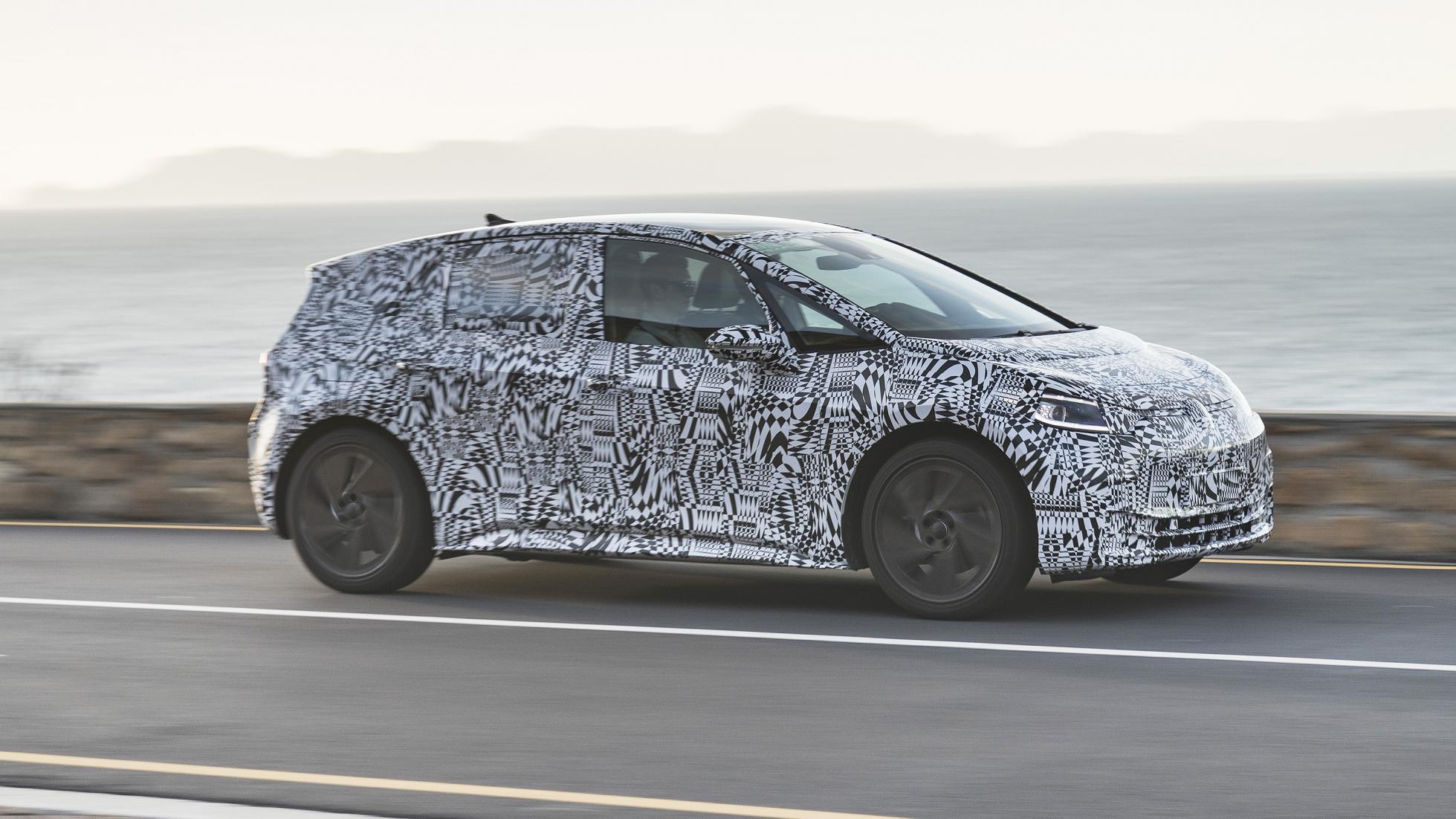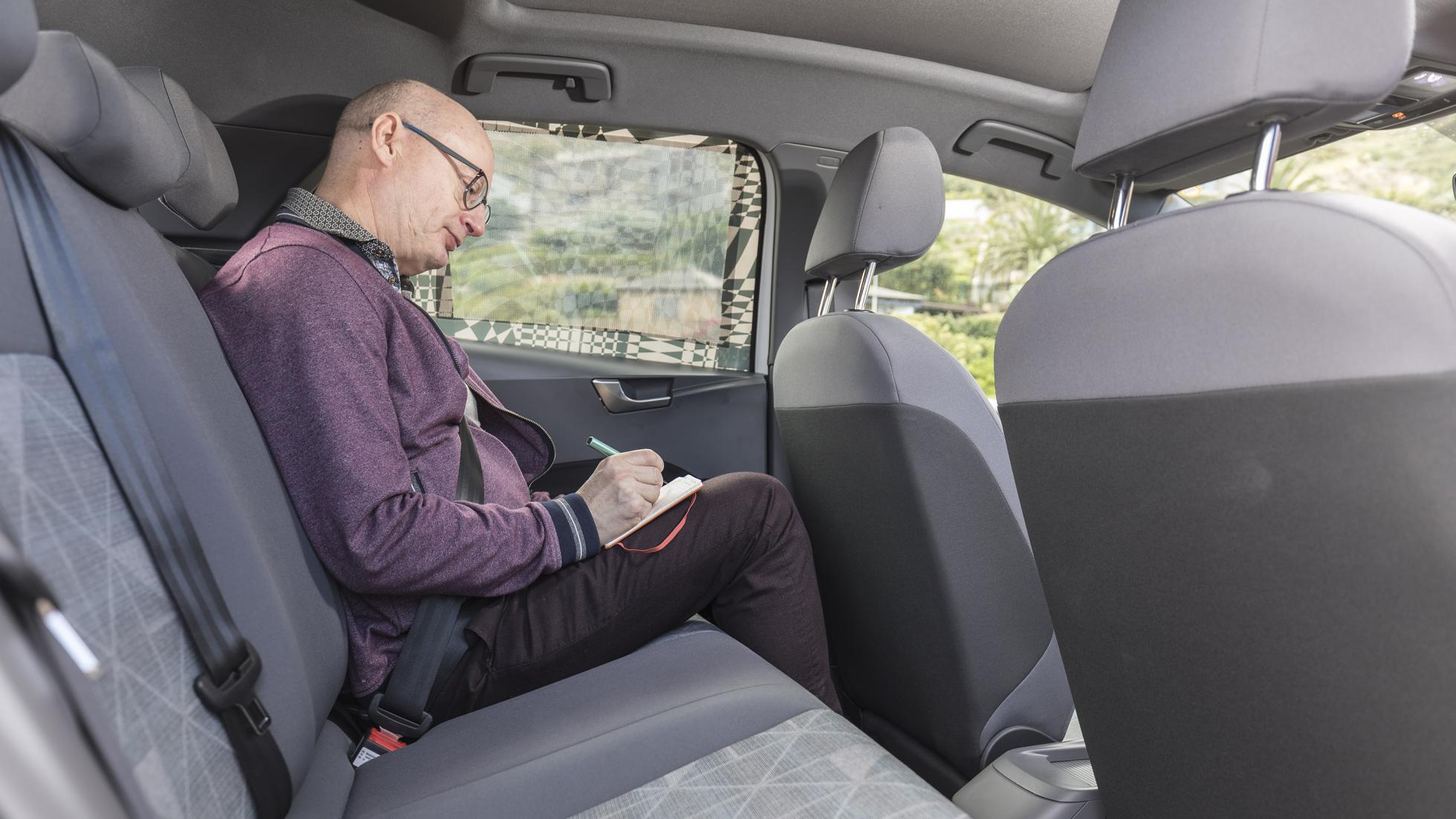Here's what we learned driving Volkswagen's I.D. electric car

Stare at this wrap too long and you’ll get a migraine. But please stare a bit, because beneath it lurks the car that has to transform Volkswagen into its third era.
In the mid-1970s the Beetle company became the Golf company. Now, VW insists that from 2020, it’ll become the number one electric car company, churning them out by the hundreds of thousands. Eventually the millions.
The concept car was called the I.D. VW people won’t say if that’s the final name. It doesn’t go on sale for another year, but even so they’re letting Top Gear drive this ridiculously precious prototype. We’re on roads near Cape Town, South Africa, where the car is doing some weeks of hot-weather testing. The morning we arrive, it’s raining.
VW says this hatchback will cost the same as a diesel Golf with comparable equipment. It’s the same size outside as the Golf, and makes about 180bhp. Even from this prototype, it’s clear that in most significant ways it’ll be a nicer prospect than the Golf.
It’s pushed along by a near-silent electric drivetrain, and it’s got the potential to be more fun because it’s rear-drive. Its body is strikingly progressive and pretty. The ultra-modern cabin is airy and far roomier than a Golf’s.
The base version will have a WLTP range of over 206 miles, and there will be the option for 310-plus miles. That’s as far as you can go without a comfort break, or you’re a better man than I am, Gunga Din.

Design
You can see the I.D. concept car here, and the real thing is spookily faithful. Well, it’s spooky until you’re told the production car was well down the design pipe when they did the so-called concept. It’s the same one-box shape, with big wheels pushed right to the corners.
VW’s combustion cars evolve conservatively, and they’ll continue to do so. Look at successive generations of Polo or Golf. By contrast, VW is making a step-change with the I.D. concept car series, all of which will become production reality… except the I.D. R racer, sadly.
So we get a laid-back windscreen pushed forward over a short nosey bonnet. The side-window line drops as it comes back towards the driver, runs horizontal, and then rises again towards the back. The production car’s wheels are 20-inchers and it would look odd on less. The tailgate is glossy black below the glass. The headlight graphic is much the same as the concept’s. The tail lights aren’t so shallow, but they wrap around in the same way.
The production version has a more conventional grille at the front below the bumper. And no pillar-free sliding doors, obvs.
Driving
Any tickle of your right foot gets torquey, quick-witted and silent action. Because that’s how electric cars are. The motor is the permanent-magnet type, the engineers saying it’s easier to make these behave smoothly than Tesla’s induction motor. Mind you, there’s still a bit of work to do to make it move off from rest without a little jolt. It’s a prototype, eh.
You’ve got two ways to slow down. Normally when you lift off the accelerator the car glides on until you brake. The first part of the brake-pedal travel summons only the regenerative braking, pouring energy back to the battery. The friction brakes aren’t fed in, under computer control, until you’ve used up all the regeneration. Which isn’t very often if you’re driving normally.
You can also opt to get much of the regeneration from just lifting the accelerator – one-pedal driving. Just switch from D to B on the little switch that does the job of a transmission lever. Some people prefer that. Others think it’s more natural if the two pedals do two separate jobs. So, VW gives you the choice.
Top speed will be limited to 161kph. That’s because big cruising speeds are inefficient
It corners without much roll, staying flat and composed. The driven rear wheels give it loads of traction to scoot out of roundabouts and tight corners. A torquey front-drive car needs at least 60 per cent of its weight over the front or it’ll be short of traction. This car, because of the battery, is 50:50, so RWD was the natural choice.
More impressions than that will have to wait. They haven’t done any chassis tuning yet. Over big bumps the prototype is underdamped, and the steering is as light and feel-less as a video game.
Sitting alongside me in the car is VW’s R&D director Frank Welsch. He swears the steering will end up very nice, which makes sense as a rear-drive car puts up no torque-steer.
Absent an engine, you’re prone to noticing other noises in an electric car. They’re doing well with suppressing suspension thump and wind noise, but there’s still work to be done on tyre hum. The whole body structure feels very solid and reassuring. Like a VW.
Performance and range
There are no official performance numbers yet, or power output. But I’d guess about nine seconds to 100kph. Thing is, that’s actually worth more than the same on-paper performance in a normal car. When you see a chance to press the pedal in an electric car, you’re accelerating right now. In a petrol car you’ve got to shift down and wait for boost, by which time your other self has scuttled silently ahead.
Top speed will be limited to 161kph. That’s because big cruising speeds are inefficient, the battery depleting alarmingly quickly with every mile.
Welsch says weight isn’t the be-all and end-all, because energy lost in acceleration is mostly gained in regeneration when you slow down. So the body is almost all steel. Simply that’s the cheapest and the best for mass production.
More than weight, aero drag matters. Again, we have no figure, but this is visibly a slippery shape, and it’s smooth underneath too and has flat-faced wheels. But normal mirrors sit on the doors. The Audi e-tron has cameras and little screens, but Welsch says they take a bit of getting used to, and cost too much. At every turn in specifying this car, he was aiming at cutting cost, and reducing the intimidation threshold for new EV drivers.
For the same reason, there aren’t loads of paddle-summoned regeneration levels as the Koreans provide. Nor does the dash flash up endless pulsating energy-flow graphics to coach you in eco-driving. Driving it isn’t a science experiment. The promise of the VW badge is a car for the people.
To improve range, it’s critical the electronics and the battery don’t waste energy through heat. So they found a cell design with low internal resistance so the battery doesn’t warm up much during driving.

The long wheelbase makes a space for a big battery. Starting from scratch, VW figures out the optimum physical size for the cells. Too big and they’re hard to make, too thick and they’re hard to cool, but too small and you need more and then it’s too much expensive soldering to make a battery. When the battery is 40 per cent of the cost of making the car, this stuff matters. A lot.
Like everyone else’s, the battery pack is made up a series of modules. Think of a chocolate bar, says Welsch. They make a bar with more chocolate squares in long-range versions or the more powerful heavier crossovers and bigger cars.
The I.D. itself will come with two battery options. Their actual kWh capacity is still secret, but that’s like obsessing on the size of your fuel tank. What matters is range, and there are versions offering 332km and 502km on the relatively realistic WLTP test. The shorter-range car, having fewer modules, is well over 100kg lighter, so it accelerates faster.





Charging
The battery is liquid-cooled, so it can accept high charging current without overheating and damaging its life. It’s rated to charge at 125kW via its DC port. By 2020, charging posts that deliver that power look like being fairly common in the UK – you can already find them in Holland and Germany.
Charged up like that, 30 min will take it from zero to 80 per cent (i.e. 402 kilometres range) in 30 minutes. But whoever runs down to zero? So you’ll almost certainly be on your way sooner than half an hour.
For plugging in at home or work, there’s an 11kW on-board AC charger, which is quicker than most.
Interior
The interior isn’t much like the concept’s. At the moment the prototype’s finish is rough’n’ready so they won’t let me show you photos. Time to exercise your mind’s eye, and my descriptive powers.
The dash is pushed 15cm further forward than in a Golf, because the bulky air-con unit has moved to where your car and mine have their engines.
So the central screen is on a pedestal to get it within easy arm’s reach. This handles all the usual infotainment and connectivity, and just below it is a context-dependent touch slider to turn the volume and temperature up and down.
The driver’s screen perches on top of the steering column. Growing out of its side is a big twist-knob that gives you park, neutral, drive and reverse. And a ‘brake’ regeneration mode for people who like one-pedal driving. Including me.

It’s a pretty radical dash for a Volkswagen, but the BMW i3 designers might be flattered by what they’ll take to be imitation.
The optional head-up display is colossal, because it’ll superimpose augmented-reality visuals onto the traffic and road ahead, making it easier to make sense of the online driver-assist and navigation.
It’s the size of a Golf, with the space of a Passat. With that stretchy wheelbase, there’s all the rear knee-room you’d expect. More surprising is that the tapering roof-line doesn’t kill the headroom for adults, and the underfloor battery isn’t a total burglar of foot space. It’s comfy.
The boot is big too. Below that are the motor and the transmission. That might be the layout of the Beetle but there’s no front boot. The nose is stuffed with electronics, plus plumbing to cool or heat the people and the motor and the battery.
How many electric VWs and when?
The pressure on this car could hardly be more intense. In 2020, the first buyers get their I.D.s, and later the same year the crossover launches. By 2022 there will also be a big saloon and the microbus. Those four have all been previewed by concepts. They are called, because someone’s z-key is sticky, I.D., I.D. Crozz, I.D. Vizzion and I.D. Buzz.
In all there’ll be 27 models based on this MEB platform by the same year, 2022. They’ll be VWs, Audis, Skodas and Seats, with RWD and AWD, hatches and crossovers and saloons and vans.
By 2025 the plan is to be selling them at a rate of a million new cars a year in all. A million. It’d better be good.
That’s just the cars on this MEB platform. There’s also the Audi e-tron SUV and its coupe relative, which have an EV platform of their own, and also the Porsche Taycan and Audi e-tron GT.









So why now?
Rewind to late 2015. VW had been selling the e-Golf and e-Up before that. But the bosses had reckoned it was too soon to make large numbers of electric cars at a profit. That’s why they were so many years behind Nissan with the dedicated electric Leaf, or Tesla with the (faster and much more expensive) Model 3.
The e-Golf wasn’t a full solution. Its layout is hijacked from a combustion car, and the space for the battery is too small, and it can’t adapt to different sizes of car or van.
So they began to conceive a dedicated electric platform. It’s called the MEB. With its simply shaped modular battery and its possibility of RWD or AWD, and variable wheelbase and width, it’s more adaptable and, crucially, cheap to make.

So much for the logic. But there was another factor, one that caused them to take the MEB decision when they did, and to expedite the thing. Honestly, four years from blank sheet to production is ridiculously fast for an all-new car and concept of car.
It was the immediate aftermath of #dieselgate first coming to light. Everything was in play at VW. The bosses were super-busy all week, so they met one weekend to stand back and take big strategy decisions. It had very suddenly dawned on them that continuing to rely just on combustion engines – especially when many of them had been illegally toxic – wasn’t such a terribly smart idea at all.
They faced the choice of retrenching, or turning their company’s face boldly to the future. They chose the latter, embracing not just electric power but autonomous driving and vehicle sharing and the rest.
Sure, the VW Group will carry on making combustion cars for years if not decades. But you sense this new-mobility stuff is where its heart now beats.

